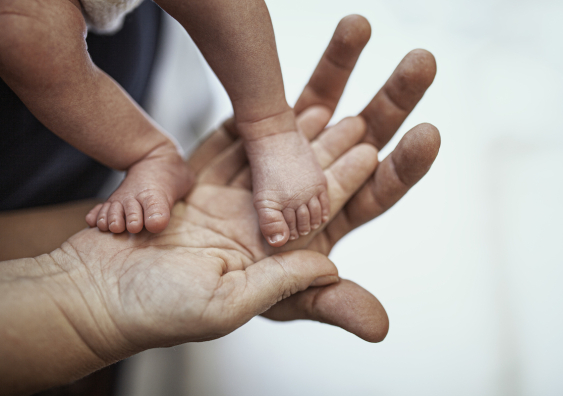A world-first estimate shows assisted reproductive technology (ART) is now part of everyday life for millions of families across the globe, with one ART-conceived baby born every 35 seconds.
A published in Fertility and Sterility estimates between 10 and 13 million babies were born via in vitro fertilisation (IVF) in the 40 years since the world’s first IVF infant was born in 1978.
The study is the first to count how many children were born through IVF across the world. The number is equivalent to more than half of Australia’s population.
“Every year we estimate how many babies were born in the previous 12 months – but we’ve never actually gone back and used a consistent methodology and extrapolation for missing data to estimate the total number of babies born in the world,” says Professor Georgina Chambers, one of the study’s lead authors and director of Â鶹Éçmadou’s National Perinatal Epidemiology and Statistics Unit (NPESU).
“We found IVF births have grown exponentially,” Prof. Chambers says.
"Preliminary global data suggests an additional 3–4 million infants were born past the study’s cutoff in 2018.
“This brings the total in 2024 to 13–17 million infants.”
Media enquiries
For media enquiries and to arrange interviews, please contact Melissa Lyne:
°Ő±đ±ô:Ěý0415 514 328
·ˇłľ˛ąľ±±ô:Ěým.lyne@unsw.edu.au
She says Australia played a formative role in IVF’s early history as the third country to successfully deliver an IVF baby in 1983.
Since then, the nation has become a global leader in both the safety and success of IVF – with data from Australia and New Zealand being among the most complete in the world.
“Australia was the first country to establish an IVF registry, thanks to the pioneers who collaborated with the NPESU and (FSANZ) in the early 1980s,” says Prof. Chambers.
She says Australia now sees one in every 16 babies born via IVF. Among women aged over 35, that figure is closer to one in 10.
Crunching the numbers
The study was based on 1978–2018 data collected on behalf of the (ICMART), of which Prof. Chambers is data custodian.
IVF is most widely used per capita in high-income nations, including Australia, where government funding and regulation support equitable access. In contrast, many low- and middle-income countries lack the infrastructure or public support to make fertility treatment a viable option.
“IVF is expensive and complex,” says Professor David Adamson, Chair of ICMART. “It requires skilled personnel, medications and high-tech labs. Without public funding or reimbursement, it's largely inaccessible in many parts of the world.”
Australia’s leading role in global IVF
IVF is practised differently in each country – particularly when it comes to the number of embryos transferred during treatment, as well as the use of frozen embryos.
“Multiple births used to be very common with IVF because clinics would transfer more than one embryo to try and improve the chance of pregnancy,” Prof. Adamson says.
“With improvements in embryo freezing techniques, embryos can now be successfully transferred in subsequent cycles,” he says.
“A single embryo transfer does not compromise overall success rates – and it is safer for mother and baby.”
Prof. Chambers says Australia has been a global leader in reducing the risk of multiple births.
“Today, more than 93% of IVF cycles involve a single embryo transfer, resulting in a multiple birth rate of below 3%,” she says.
“Most IVF babies in Australia now come from frozen embryos.”
As more babies are born through IVF, we hope access to safe, high-quality care will become more equitable – and based on human rights – across the world.
A personal tool, not a political solution
IVF plays a critical role in modern family building.
With declining birth rates across most of the world, to the effect that Europe's population will start falling from 2026, “many countries now are turning to IVF and supporting it through government funding to support or reverse the declining fertility rates”, Prof. Chambers says.
“But it's not a particularly effective pronatalist policy to fund IVF with that as its sole goal.”
She says while IVF can help individuals and couples have children, it makes only a small difference to overall fertility rates.
“Fertility treatment is a medical treatment for infertility,” Prof. Chambers says.
“While this can help increase birth rates among women in their mid-30s and older, it shouldn’t be relied on as a tool to reverse declining population trends.
“Access to fertility care should reflect the fact that it is a universal human right to build a family.
“Australia has been a global leader in recognising this – providing the financial, societal and medical support to enable its people to access fertility care equitably.”
She says IVF could have a detrimental effect on fertility rates because of a common misunderstanding that IVF can readily solve infertility if needed – where people may put off having children until an older age, when IVF is less successful. This can lead to the physical, emotional and financial strain of attempting IVF without it being successful.
Prof. Chambers says IVF isn't as successful in women over 35 because the number of eggs decreases across the lifespan, along with the quality of the eggs. This is reflected by the percentage of eggs with regular chromosomes – a percentage that drops dramatically in the late 30s and early 40s.
“For each fresh or frozen IVF cycle started in 35-year-old women, the live birth rate is around 30%. This drops to 15% for a 40-year-old and 10% for a 42-year-old.”
She says that also, generally, the later a woman has children, the fewer children she will have.
“IVF is very good at resolving childlessness in most women, especially if they are treated at younger ages, but it's not very good at closing the fertility gap in terms of the average number of children a woman will have,” Prof. Chambers says.
“Education about fertility and encouraging society to support people to have children when they want them, while remaining connected to the workforce, is shown to be the most effective policy to support fertility rates.”
Just and equitable futures for all
Behind each of the millions of IVF births is a deeply personal and emotional journey. Prof. Chambers says the data behind the study show how transformative assisted reproduction is.
“Over a relatively short period of time IVF has become an important medical and societal procedure in terms of assisting people who are infertile to have children,” she says.
“This includes same sex couples and single women – in Australia, these patients account for around 17% of cycles. However, in many parts of the world, IVF is not accessible for them.
“As more babies are born through IVF, we hope access to safe, high quality care will become more equitable – and based on human rights – across the world.”









